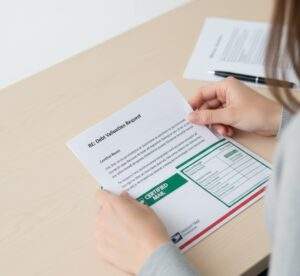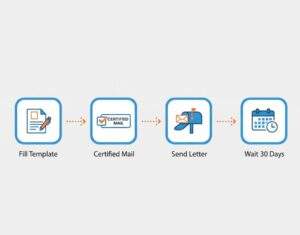Receiving a notice from a debt collector can be incredibly stressful. Your first instinct might be to panic, but it’s crucial that you don’t ignore it or immediately pay. You have legal rights, and the most powerful first step you can take is to make the collection agency prove the debt is actually yours. This article will give you the tool and knowledge to do just that with a free debt validation letter template and a clear explanation of your rights under federal law.
What Is a Debt Validation Letter and Why You MUST Send One
So, what is a debt validation letter? It is a formal written request you send to a collection agency, demanding they provide proof that you owe the debt they are trying to collect. This isn’t just a polite request; it’s a right guaranteed to you by the Fair Debt Collection Practices Act (FDCPA).
Sending this letter is the single most important action you can take. Here’s why:
- It Puts the Burden of Proof on Them: The collector must prove the debt’s validity, the amount, and that they have the legal right to collect it from you.
- It Stops Collection Activity: The FDCPA mandates that once a collector receives your written validation request, they must cease all collection efforts—no more calls, no more letters—until they send you verification of the debt.
- It Protects You from Scams: It forces the agency to prove they are legitimate and not a phantom debt collector trying to scam you.
- It Creates a Paper Trail: This letter, especially when sent correctly, serves as legal proof that you have disputed the debt.
Challenging a debt collector is not an admission of guilt; it is a smart, strategic move to protect your finances and your rights.
Free Debt Validation Letter Template [Copy & Paste]
Here is a complete, copy-and-paste-ready template. Simply replace the bracketed information with your own. Do not add any extra information or explain your situation. Keep it formal and to the point.
[Your Full Name]
[Your Street Address]
[Your City, State, Zip Code]
[Date]
[Collection Agency Name]
[Collection Agency Street Address]
[Collection Agency City, State, Zip Code]
RE: Account Number: [Account Number from their letter, if any]
To Whom It May Concern:
I am writing in response to your contact on [Date of their first contact] regarding the above-referenced account. This letter is a formal request for validation of the debt you claim I owe. This is not a refusal to pay, but a notice that your claim is disputed.
Pursuant to my rights under the Fair Debt Collection Practices Act (FDCPA), 15 U.S.C. § 1692g, I demand that you provide me with the following information:
1. Proof that you are licensed to collect debts in my state.
2. The name and address of the original creditor.
3. The date the original account was opened and the original account number.
4. A complete accounting of the alleged debt, including all principal, fees, interest, and charges.
5. Verification that the statute of limitations for collecting this debt has not expired in my state.
6. A copy of the original signed contract or agreement between myself and the original creditor.
Until you provide this validation, you must cease all collection activities related to this debt, including any reporting to the credit bureaus. Any attempt to continue collection efforts without providing this proof will be considered a violation of the FDCPA.
This is a formal dispute, not a request for you to call me to discuss the matter. All future correspondence should be in writing and sent to the address above.
Sincerely,
[Your Full Name - Printed, DO NOT SIGN]
How to Use and Send Your Letter: A Step-by-Step Guide
Knowing how to respond to a collection agency letter is critical. Sending the template correctly is just as important as the content itself. Follow these steps precisely.
- Fill In the Blanks: Carefully copy the template above and fill in all the
[bracketed]information. Double-check the collection agency’s name, address, and your account number. - Do Not Sign It: Print your name at the bottom, but do not provide your handwritten signature. This is a small but important step to prevent potential signature forgery.
- Keep a Copy for Yourself: Make a photocopy or save a digital version of the exact letter you are sending for your personal records.
- Send it via Certified Mail with Return Receipt: This is non-negotiable. Go to the post office and send the letter via Certified Mail with a Return Receipt Requested. This costs a few extra dollars, but it provides you with a mailing receipt and a delivery receipt proving exactly when the collection agency received your letter. This is your legal proof.
Remember, you have a 30-day window from the collection agency’s first contact with you to send this letter to have the strongest legal standing.
After You Send the Letter: Monitor Your Credit
Once you’ve mailed your letter, the waiting begins. But you can be proactive. It is essential to monitor your credit report to see if this collection account appears and how it’s being reported. An incorrect collection account can seriously damage your credit score.
Regularly checking your credit allows you to:
- Confirm if the collector has illegally added the disputed account to your report.
- See if the account is removed if they fail to validate it.
- Catch any other errors or fraudulent activity early.
Consider using a credit monitoring service to get instant alerts about changes to your credit report. This puts you in a position of power and ensures the collection agency is held accountable. [Insert Affiliate Link to a Credit Monitoring Service Here]
Conclusion
Facing a debt collector is intimidating, but you are not powerless. By sending a formal debt validation letter, you shift the power dynamic and force them to operate within the strict rules of the law. You have taken the correct, powerful first step to protect yourself.
Keep a copy of your letter and your certified mail receipts in a safe place. Now, you wait for their written response. Whatever happens next, you can be confident that you have handled the situation intelligently and asserted your consumer rights.
Frequently Asked Questions (FAQ)
What is the difference between a debt validation letter and a 609 dispute letter template?
A debt validation letter is sent to a debt collector under the FDCPA to demand they prove you owe a debt. A 609 dispute letter template is sent to the credit bureaus (Equifax, Experian, TransUnion) under the Fair Credit Reporting Act (FCRA) to dispute information on your credit report that you believe is inaccurate or unverified. You send the validation letter first to the collector; you send a 609 letter later to the bureaus if inaccurate information appears on your report.
What happens if the collection agency doesn’t respond or can’t validate the debt?
If they don’t respond within a reasonable time (e.g., 30 days) or cannot provide the requested proof, they are legally barred from continuing to collect the debt. They cannot call you, write to you, or list the debt on your credit report. If they do, they are in violation of the FDCPA, and you may be able to take legal action against them.
Can I still be sued after sending a debt validation letter?
Yes, it is possible. Sending a validation letter does not prevent a lawsuit. However, if a collector sues you without first validating the debt after you’ve requested it, this can be used as a strong defense in court. Many collectors will not risk a lawsuit if their documentation is weak.
Is there a deadline for sending a debt validation letter?
Yes. To get the full legal protection of the FDCPA, including the right to force them to cease collection activities, you must send the letter within 30 days of the collection agency’s first contact with you. While you can send it after 30 days, it may not carry the same legal weight.
Your Essential Guide to Challenging Debt Collectors and Protecting Your Rights.PDF
Hi, I’m [jeybee]. As a long-time resident of Seoul, I’m passionate about uncovering the authentic, everyday magic of Korea. This blog is my way of sharing my favorite spots, tips, and cultural insights with you, beyond the usual tourist traps.




